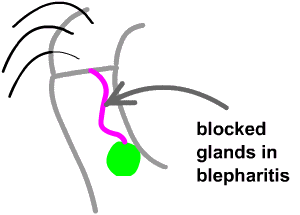Marginal Corneal Ulcers David Kinshuck & Shabbir Mohamed |
What is a marginal ulcer? |
| A marginal ulcer is a small ulcer on the front part of your eye, the cornea. The cornea is the clear 'window' of the eye'. An 'ulcer' is a shallow crater, a bit like a crater on the surface of the moon. A 'marginal ulcer' is a shallow ulcer on the surface of the cornea. |
The cornea a marginal ulcer: the eye is red just near the ulcer (the ulcer appears green when the doctor or nurse places a special fluorescent dye drop in your eye) Below, a side view |
|
|
|
What is happening? |
| The ulcer forms as part of your body's reaction to bacteria (germs). Some bacteria are trapped in the eyelids, and some are naturally present on the surface of everyone's eyes. The bacteria may invade the surface of the cornea, and your body's immune system reacts to the bacteria to make the ulcer. When the body 'overreacts' an ulcer forms. |
||
What do you feel? |
|
At first your eye starts to feel a little sore, as though something may be in it, and a little bit achy. About 1-2 days later it may start to water and be painful and red. Bright lights become painful, and your eye may become sticky and difficult to open in the morning. |
||
Treatment |
|
There are two parts to the treatment: |
||
For the ulcer itself |
You are usually given steroid drops to put in your eye. These stop the eye's immune system overreacting and so allows the ulcer to heal. The steroid drops, such as Predsol or Predsol-N, generally have no side effects for the short time they are needed (1-3 weeks). The ulcer usually gets a little better in a day, and completely better in a week. Sometimes an antibiotic drop is needed such as the 'N' part of Predsol-N or chloramphenicol to stop a more serious infection of the cornea. |
||
To prevent a cycle of recurrences |
| Doctors believe that the bacteria in the glands of the eyelids help to cause these ulcers. Some people develop marginal ulcers quite frequently, perhaps every few months. You may be able to stop more ulcers developing, or at least make them less frequent, by cleaning your eyelids regularly. The cleaning helps to reduce the number of bacteria in the glands of the lid. The advice below is modified from Birmingham & Midland Eye Centre advice sheet. You need
|
 |
Warm compresses
Clean the edge of your eyelids (the eyelash edge) with a wet cotton bud. Gently scrape off the debris moving the bud side to side. First try warm sterile water, that is boiled water allowed to cool but still warm. (Warm tap water is usually quite safe.) Some people recommend a bicarbonate solution instead of plain water. Use a teaspoon of bicarbonate of soda, available from a chemist or supermarket bakery sections, to a pint of water. You can use this solution for a few days, keeping it in the fridge. Use a small amount each time. Looking in a mirror, pull your lower eyelid down with the index finger
of one hand, and gently but firmly wipe the bud along the edge of the
lid to scrape the debris off. Antibiotic cream An antibiotic cream may help (as below); this can be squirted into the eye, or squirted onto your finger, and you can then spread it over the eyelids. Alternatively, apply the ointment with the cotton bud onto the eyelid.If you develop marginal ulcers every month for several months, antibiotic treatment may be helpful. An antibiotic cream may help, such as Fucithalmic twice daily for one or more months, depending on how frequent your ulcers are. If this does not work, and your ulcers are very troublesome, tablets
may help: providing you are not pregnant and are otherwise well ...
ask your doctor first. Oxytetracycline (again if not pregnant) 250mg twice daily for 3 months, or erythromycin are alternatives. Generally you should have seen an ophthalmologist at least a couple of times with ulcers before considering tablets. |
Gently clean with a cotton bud, looking in mirror |
What to expect |
| A typical attack will last a
week without treatment, sometimes getting better without drops. With drops
(Predsol N or equivalent) your eye will feel a lot better the next day,
nearly recovered in 3-4 days, and nearly back to normal after a week.
Occasionally you may notice recurrences even with these 'preventative' measures, but gradually the episodes become fewer with longer between. If there is no improvement in 2 days, you may have a different type of ulcer. You should certainly seek advice from an Ophthalmologist if your eye gets worse not better. |
Leaflet download |
| If you are a health professional and want to have a leafet to give to give to patients, instead of this web page, see 180k Adobe. Alternatively, this is a Microsoft Publisher document click here, and you are welcome to download it and print copies. You are welcome to make changes for your patients (you can edit the leaflet in Microsoft Publisher). You will need M Publisher 2000 to open and
print the document. M Publisher is bundled as part of Microsoft Office.
The only condition is that you let me know if there are any errors. |
 |
| The address of this site ('org' changing to 'nhs') is changing from http://www.goodhope.org.uk/departments/eyedept/ to http://www.goodhope.nhs.uk/departments/eyedept/ |
|